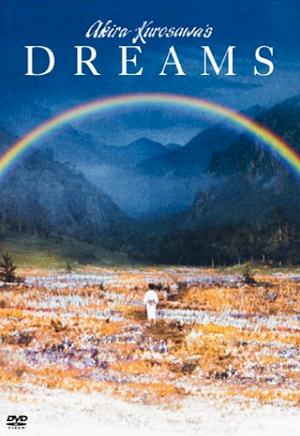
Dreams is a 1990 film directed by Akira Kurosawa. Kurosawa was eighty years old when the film was released, and it draws from various dreams and nightmares he experienced over the course of his long lifetime. With forty years of experience, Dreams is the 28th film Kurosawa has directed. The film is composed of several distinct and disconnected stories -- there are various themes and overtones that encompass the entire film, with distinctive moods and emotions for each of the individual pieces, ranging from temptation and tiredness to art and environmental pollution.
Kurosawa draws not only from his own dreams but the Japanese culture in which he grew up; common features include the Kitsune, a mythical Japanese fox character. As these creatures are typically portrayed as magic-using tricksters, Kurosawa does not deviate -- in his first story, a little boy views the Kitsune wedding ceremony and draws their ire. Blossoms are another common feature to traditional Japanese culture; they make an appearance later, in "The Peach Orchard." In addition, Kurosawa also draws upon his own fears -- with "The Tunnel" he examines war and death, and with "Mount Fuji in Red" he explores a potential nuclear holocaust and the effect on a family remaining behind.
Symbolism is key throughout the story, and various characters represent different things -- the still-living soldier in "The Tunnel" represents guilt. Clearly, the soldier feels horribly not only for his lost platoon, but those he may have killed over the course of the war as well. Most of the characters and representations follow a similar theme, however -- death and time are important motifs throughout the story. Many of the stories near the end feature a sort of end to the earth -- "Mount Fuji in Red" and "The Weeping Demon," both sequences near to the end of the movie, deal with a nuclear apocalypse and the aftereffects.
Though Dreams has a sensible progression of time (the first stories focus around a young boy, while the last stories focus around an old man), there is little else leaving the film easily accessible and understandable. The abstract nature of the film, as well as the lack of transitioning between sequences, work well for the sort of film that Kurosawa wanted to make -- however, this feels as though it was a film created by Kurosawa for Kurosawa. Perhaps it was his way of dealing with aging and getting older. It is difficult for a younger viewer to simply watch the film and fully absorb the message Kurosawa is attempting to convey -- it is the sort of film that requires intense retrospect to fully comprehend.
No comments:
Post a Comment